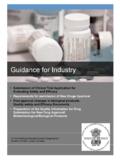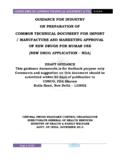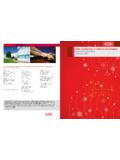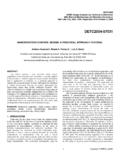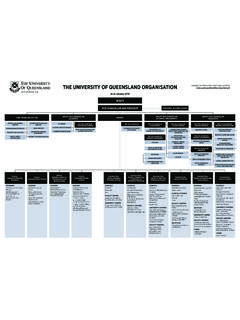Transcription of THE LNG VALUE CHAIN - Renewable Energy Investors
1 THE LNG. VALUE CHAIN . MAY 2013. Disclosure Forward-Looking Statements: This presentation includes forward-looking statements within the meaning of the Private Securities Litigation Reform Act of 1995. The use of words such as may , might , should , will , expect , plan , anticipate , believe , estimate , project , forecast , outlook , intend , future , potential or continue , and other similar expressions are intended to identify forward-looking statements. All of these forward-looking statements are based on estimates and assumptions by our management as of the date of this presentation that, although we believe to be reasonable, are inherently uncertain. Forward-looking statements involve risks and uncertainties that could cause the Company's actual results or circumstances to differ materially from those expressed or implied by forward-looking statements. These risks and uncertainties include, among others, the following: the cyclicality of the markets that the Company serves; a delay, significant reduction in or loss of purchases by large customers; fluctuations in Energy prices.
2 The potential for negative developments in the natural gas industry related to hydraulic fracturing; changes in government Energy policy or failure of expected changes in policy to materialize; competition; economic downturns and deteriorating financial conditions; our ability to manage our fixed-price contract exposure; the Company's ability to successfully manage its costs and growth, including its ability to successfully manage operational expansions; our reliance on key suppliers and potential supplier failures or defects; the modification or cancellation of orders in our backlog; changes in government healthcare regulations and reimbursement policies; general economic, political, business and market risks associated with the Company's global operations and transactions; our ability to successfully acquire or integrate new product lines or businesses, including the ability to successfully integrate those businesses; the loss of key employees and deterioration of employee or labor relations; litigation and disputes involving the Company, including product liability, contract, warranty, employment and environmental claims; the adequacy of our warranty reserves; fluctuations in foreign currency exchange and interest rates; the financial distress of third parties; the regulation of our products by the Food & Drug Administration and other governmental authorities; the pricing and availability of raw materials; potential future impairment of the Company's goodwill and other intangibles; the cost of compliance with environmental, health and safety laws; our ability to protect our intellectual property; technological security threats; additional liabilities related to taxes.
3 The impact of severe weather; risks associated with our indebtedness, leverage, debt service and liquidity; and volatility and fluctuations in the price of the Company's stock. For a discussion of these and additional risks that could cause actual results to differ from those described in the forward-looking statements, see disclosure under Item 1A. Risk Factors in the Company's most recent Annual Report on Form 10-K and other recent filings with the Securities and Exchange Commission, which should be reviewed carefully. Please consider the Company's forward-looking statements in light of these risks. Any forward-looking statement speaks only as of its date. We undertake no obligation to publicly update or revise any forward-looking statement, whether as a result of new information, future events or otherwise, except as required by law. 1. Company Overview Chart Industries is a leading provider of highly engineered cryogenic equipment for the hydrocarbon, industrial gas, and biomedical markets Technology leader that provides high-end equipment to the Energy industry , which is the largest end-user of Chart's products One of the leading suppliers in all primary markets served Global footprint for our operations on four continents with approximately 4,900 employees More than half of sales outside the and more than half made to the Energy markets FY 2012 Sales by Segment FY 2012 Sales by End-User FY 2012 Sales by Region Americas BioMedical General (Non-US) RoW.
4 BioMedical Energy &. 21% Industrial 6% 9%. 21% Chemicals 32% 25%. Asia 25% 44%. Distribution Europe Energy & Storage 16%. 54%. 47%. 2. Energy Demand Drivers Global Energy demand is expected to grow 35% by 2035(1), driven by a few key structural growth drivers: POPULATION GROWTH. (World population, in billions). Source: US Census Estimates WORLD COMMERCIAL Energy USE. (billion tons of oil equivalent). 1970 1990 2010 2030. INDUSTRIAL PRODUCTION INTENSITY. (World GDP (2) per capita, in USD thousands). Source: IMF World Economic Outlook, April 2012 1980 1985 1990 1995 2000 2005 2010 2015. 117. GLOBALIZATION. (World GDP, in USD trillions, 2005 prices). Source: ExxonMobil Outlook for Energy , View to 2040 Non-OECD. 51. 40. 30 OECD. Source: BP Energy Outlook 2030, * Renewables include biofuels 1990 2000 2010 2040. (1) Growth from 2010-2035, Source: IEA/OECD World Energy Outlook Special Report - Golden Rules for a Golden Age of Gas , Golden Rules Scenario (2) World GDP based on Purchasing Power Parity (PPP).
5 3. Parameters for a New Energy Future Changes to Energy supply sources will be driven by three parameters: Stricter Countries seek Energy Independence Solution must Emissions Economics spread demand legislation to security in national across Energy reduce air resources supply sources pollution /. carbon levels Shift reliance New away from OPEC. infrastructure National Energy projects must plans focus on Diversify Energy payback with cleaner Energy portfolio low operating sources and costs technology 4. Benefits of Natural Gas Gas/Oil Spread Levelized electricity costs assuming (cents per kWh, 2020). ECONOMICS $ Coal gas price Crude oil / natural gas spread Nuclear Wind continues to grow Gas Lower expected power costs for Capital/Fixed Costs gas fired combined cycle plants Nat Gas Oil (WTI) Variable/Fuel/Trans. Costs (BOE*) April 2013 Source: EIA (AEO 2013). Emissions levels per 1 BTU (relative to coal).
6 EMISSIONS 100 98 100 100. The cleanest fossil fuel 79 Gas of CO2 emissions vs. coal 56. 43 Oil Power gen. produces minimal 20 Coal sulfur oxides and particulates 0. CO2 NOx SO2 Source: EIA. Domestic Shale Reserves Energy INDEPENDENCE. Ample reserves both domestically and globally Reduced reliance on oil Growth of unconventional sources Source: EIA. *BOE = Barrel of Oil Equivalent based on 1 barrel =. 5800 cu ft of gas 5. Natural Gas Demand Growth Given these parameters, NATURAL GAS stands to benefit. Global Energy Demand by Fuel Type Natural gas as a share of total Energy (Quadrillion BTUs) consumption by sector 240. 220 2010 2040 Fabricated Metals 58%. 200. Transportation Equipment 54%. 180. 160 Other Manufacturing 47%. 140. Machinery 46%. 120. 100 Glass 41%. 80. 60 Refineries 39%. 40. Chemicals 36%. 20. 0 Iron & Steel 31%. Oil Gas Coal Nuclear Biomass Wind /. / Other Solar / Aluminum 31%. Source: ExxonMobil The Outlook for Energy , A View to 2040 Hydro Sources: EIA, CIRA.
7 Natural gas demand is expected to Low Energy costs will drive grow faster than coal & oil demand growth in all sectors 6. Unconventional Gas Revolution . Advances in technology, including hydraulic fracturing, have led to higher production efficiency for unconventional gas and a growth in reserves. US Gas Production by Source Gas Reserves by Country (tcf). (tcf/year) 28. 0 500 1,000 1,500. 22 China 14 US. 5. Argentina 6 Mexico 6 South Africa 2. 2 Australia 9 Canada 6. Libya Algeria Technically Recoverable 2010 2035 Shale Gas Resources Shale Brazil Proven Nat Gas Resources Tight gas Poland Coal bed methane France Data Source: EIA, (AEO 2012) Conventional Image: Time Magazine Source: EIA, Morgan Stanley Research Natural gas production in the US International shale reserves have will continue to grow yet to be monetized 7. Liquefied Natural Gas (LNG). What is LNG? Natural gas cooled to -260 F (-162 C). Clear, colorless non-toxic liquid Efficient High Energy density comparable to diesel and petrol more fuel stored in the same space versus CNG.
8 Safe Not explosive in an uncontained environment Rapidly evaporates when exposed to atmosphere and leaves no residue on soil or water Non-toxic Non-pressurized No major accidents, safety or security issues in over 50 years of commercial use Transportable Reduced to 1/600th of its original volume making it easy to transport 8. LNG Opportunities LNG fuel use predicted to increase, particularly in high fuel consumption applications: Drill rig (immediate). Pressure pumping (immediate). Truck (1 year). Marine (1-3 years). Mining (3-5 years). Locomotives (3-5 years). Other high fuel use industrial applications LNG fuel supply and infrastructure expected to increase Source: Gladstein, Neandross & Associates December 2012. 9. LNG Opportunities Current regional differences in natural gas supply, infrastructure, and prices provide support for investment in LNG applications & projects World LNG Estimated Landed Prices ($US / MMBTU) Pre-treatment Liquefaction Baseload LNG.
9 Small/Mid-Scale LNG. $10. Japan LNG Carriers Spain $17. $3-4 $14 China Tankers Distribution India $16 Virtual Pipeline $16. Brazil Satellite Storage $16 Infrastructure Bulk LNG Tanks MicroBulk Applications End Use Commercial Source: Federal Energy Regulation Commission and Applications Residential Waterborne Energy , Inc (Updated: 3/7/2013). Power Generation Transportation 10. LNG VALUE CHAIN Chart the industry 's unrivalled integrated supplier and a worldwide leader in Liquefied Natural Gas (LNG) equipment for transportation and Energy . Uniquely positioned to address the entire LNG VALUE CHAIN liquefaction, distribution, storage and end-use we bring many years of experience in LNG. solutions to our customers, facilitating the use of a clean-burning, safe fuel alternative to diesel into your future. 11. LNG VALUE CHAIN Liquefaction Overview Liquefaction Chart is a leader in liquefaction solutions & Mission Critical Equipment Brazed Aluminum Heat Exchangers (BAHX).
10 Cold Boxes Process Systems: Proprietary process technology - IPSMR . Standard LNG plants for small and mid-scale gas monetization Modular LNG solutions 12. Brazed Aluminum Plate & Fin LNG VALUE CHAIN Heat Exchanger Liquefaction Chart's Brazed Aluminum Heat Exchangers (BAHX) are a critical component for the liquefaction of hydrocarbon mixtures and the recovery or purification of methane (LNG), ethane, propane, and ethylene Chart's BAHX Advantage: 2 - 20 streams -269oC / +204oC. Versatile design 0 -160 bar Surface area-to- volume >1000. Compact m2/m3. 1oC approach Thermal margin 13. LNG VALUE CHAIN Cold Box Manufacturing Liquefaction 14. LNG VALUE CHAIN BAHX for LNG Liquefaction Liquefaction BAHX are significantly less expensive than coil wound heat exchangers (CWHE). Modular construction, plug & play' cold box solution and minimal field Economy . construction result in reduced installation costs and a shorter overall schedule CWHE are heavier & bulkier for the same level of performance, which means increased transportation limitations/costs and increased field construction Increased customer choice several BAHX vendors versus two for CWHE.
